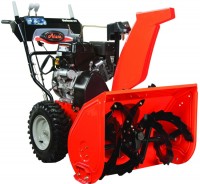Forte KCM-62E
 | Outdated Product Motor type: petrol; Working width (cm): 62; Snow height (cm): 51; Adjustable throw direction; Throw distance adjustment; Max. throw distance (m): 12; self-propelled; Number of gears: 4 forward / 1 back; Motor power (hp): 5.5; Motor power (W): 4045; Starter: electric starter (mains 230 V) |
|
| |||||||||||||||||||||||||||||||||||||||||||||||||||||||||
Always clarify the specifications and configuration of the product with the online store manager before purchasing.
Catalog Forte 2025 - new arrivals, bestsellers, and the most relevant models Forte.
Lawn care equipment is the basis of Forte products. In the winter season, a self-propelled snow plow with the model index KCM-62E is in high demand. No matter how trite it may sound, but it attracts the public with an optimal ratio of price and functionality.
Self propelled vehicle
The snow blower does not need the pushing force of the operator. The user only needs to direct the model in the right direction and select a speed that is comfortable for movement. The pace of the trip is set by setting one of four gears for moving forward or reverse, which is useful for bypassing stationary or stubborn obstacles.
omnivorous
The model is suitable for cleaning thick layers of snow (up to half a metre high), compacted snow layers and even ice blocks — all this is effectively handled by a steel auger, which grinds the snow mass into small particles. Then they are pushed out by a rotary mechanism through the socket at a distance of up to 12 m from the harvesting area.
Trouble-free snow blower
To prevent damage to delicate paving slabs or other artificial pavement surfaces, the machine operator can adjust the height of the bucket. As for fuel consumption, on a full tank of gasoline (3.6 L), a snow blower can travel around the perimeter of a personal plot for more than 4 hours in a row — the engine of the model with a capacity of 5.5 hp. consumes only 0.8 liters of fuel per hour. Also, in the category of positive aspects of the Forte KCM-62E, it is necessary to record the electric start function, which guarantees the start of the motor at extremely low temperatures, when the mercury column of the thermometer drops to around -35 °C.





